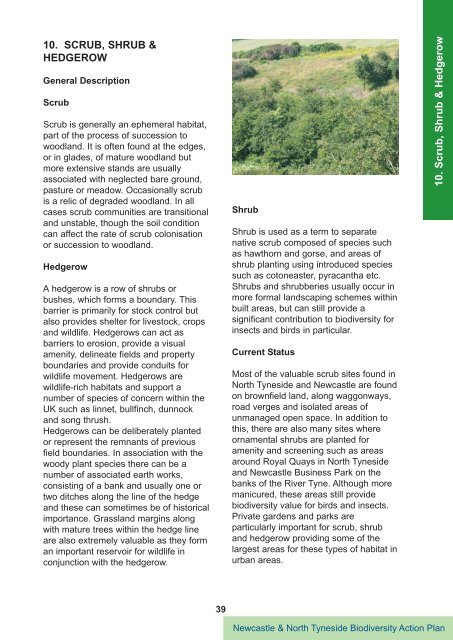III. Species Action Plans - Newcastle City Council
III. Species Action Plans - Newcastle City Council
III. Species Action Plans - Newcastle City Council
Create successful ePaper yourself
Turn your PDF publications into a flip-book with our unique Google optimized e-Paper software.
9. Lowland Grassland<br />
10. Scrub, Shrub & Hedgerow<br />
10. SCRUB, SHRUB &<br />
HEDGEROW<br />
General Description<br />
Scrub<br />
Scrub is generally an ephemeral habitat,<br />
part of the process of succession to<br />
woodland. It is often found at the edges,<br />
or in glades, of mature woodland but<br />
more extensive stands are usually<br />
associated with neglected bare ground,<br />
pasture or meadow. Occasionally scrub<br />
is a relic of degraded woodland. In all<br />
cases scrub communities are transitional<br />
and unstable, though the soil condition<br />
can affect the rate of scrub colonisation<br />
or succession to woodland.<br />
Hedgerow<br />
A hedgerow is a row of shrubs or<br />
bushes, which forms a boundary. This<br />
barrier is primarily for stock control but<br />
also provides shelter for livestock, crops<br />
and wildlife. Hedgerows can act as<br />
barriers to erosion, provide a visual<br />
amenity, delineate fields and property<br />
boundaries and provide conduits for<br />
wildlife movement. Hedgerows are<br />
wildlife-rich habitats and support a<br />
number of species of concern within the<br />
UK such as linnet, bullfinch, dunnock<br />
and song thrush.<br />
Hedgerows can be deliberately planted<br />
or represent the remnants of previous<br />
field boundaries. In association with the<br />
woody plant species there can be a<br />
number of associated earth works,<br />
consisting of a bank and usually one or<br />
two ditches along the line of the hedge<br />
and these can sometimes be of historical<br />
importance. Grassland margins along<br />
with mature trees within the hedge line<br />
are also extremely valuable as they form<br />
an important reservoir for wildlife in<br />
conjunction with the hedgerow.<br />
39<br />
Shrub<br />
Shrub is used as a term to separate<br />
native scrub composed of species such<br />
as hawthorn and gorse, and areas of<br />
shrub planting using introduced species<br />
such as cotoneaster, pyracantha etc.<br />
Shrubs and shrubberies usually occur in<br />
more formal landscaping schemes within<br />
built areas, but can still provide a<br />
significant contribution to biodiversity for<br />
insects and birds in particular.<br />
Current Status<br />
Most of the valuable scrub sites found in<br />
North Tyneside and <strong>Newcastle</strong> are found<br />
on brownfield land, along waggonways,<br />
road verges and isolated areas of<br />
unmanaged open space. In addition to<br />
this, there are also many sites where<br />
ornamental shrubs are planted for<br />
amenity and screening such as areas<br />
around Royal Quays in North Tyneside<br />
and <strong>Newcastle</strong> Business Park on the<br />
banks of the River Tyne. Although more<br />
manicured, these areas still provide<br />
biodiversity value for birds and insects.<br />
Private gardens and parks are<br />
particularly important for scrub, shrub<br />
and hedgerow providing some of the<br />
largest areas for these types of habitat in<br />
urban areas.<br />
10. Scrub, Shrub & Hedgerow<br />
<strong>Newcastle</strong> & North Tyneside Biodiversity <strong>Action</strong> Plan

















